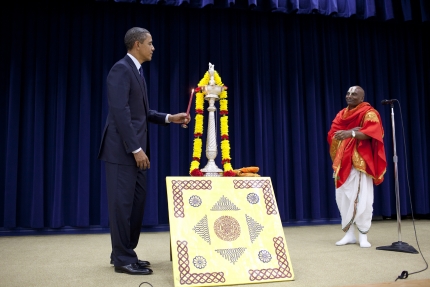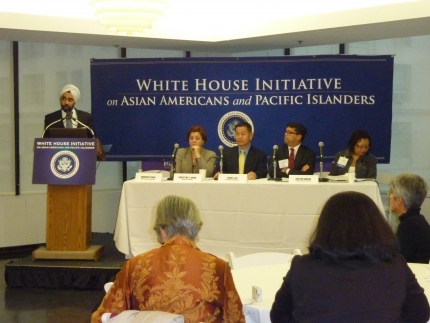Initiative on Asian Americans and Pacific Islanders Blog
Connecting Business and Government in the AAPI Community
Posted by on November 18, 2011 at 1:10 PM EDTRecently, I participated in a small business roundtable with the Asian-American Pacific Islander community in Philadelphia. The event was co-hosted by the National Association of Asian American Professionals and the Mayor's Commission on Asian American Affairs, and we were joined by 40 small business owners for a lively discussion on how to do business with the Federal Government.
Part of our mission at the General Services Administration (GSA) is to make sure that small firms across the country have the opportunity to do business with the government, and we were able to pass on several strategies that small businesses can use to successfully compete in the Federal market.
First, FedBizOpps is an online tool to help businesses learn about upcoming opportunities with the government. Small businesses can use this tool to preview what the government is looking to buy in the near future. GSA also posts a Forecast of Contracting Opportunities, informing vendors of anticipated contracts offered by GSA for the current fiscal year.
Another strategy that small businesses can use to break in to the Federal market is sub-contracting, partnering and teaming. Many small businesses find that with no previous track record with Federal Government contracts, it is hard to get their foot in the door. By joining forces with a more experienced vendor, small businesses can increase their capacity and experience. GSA's Sub-Contracting Directory lists large business prime contractors who are required to establish plans and goals for subcontracting with small business firms.
Finally, GSA's Mentor-Protégé Program is designed to encourage and motivate GSA prime contractors to assist small businesses and enhance their capability of performing successfully on GSA contracts and subcontracts. The program is intended to foster the establishment of long-term relationships between small businesses and GSA prime contractors and increase the overall number of small businesses that receive GSA prime contract and subcontract awards. To date there are over 90 Mentor Protégé agreements in place.
Learn more aboutLet’s Move! Community Leaders as Models for Change
Posted by on November 16, 2011 at 5:15 PM EDTOn November 12, 2011, First Lady Michelle Obama visited MA`O Organic Farm (MA`O) in my hometown, the community of Waianae, located on the Hawaiian island of Oahu. Waianae is home to one of the largest populations of Native Hawaiians in the world, and unfortunately the community’s poverty, diabetes, obesity and high school drop-out rates are among the highest in the state. MA`O was founded to address these incredible challenges. It is a not-for-profit, fully certified organic farm that utilizes sustainable agriculture to serve the people of Waianae. Given the First Lady’s passion for health and nutrition, we were honored and proud to welcome her to MA`O.
The First Lady has made health and nutrition issues a national priority. Last year, she launched the Let’s Move! Campaign to bring together community leaders, teachers, doctors, nurses, and parents in a nationwide effort to tackle the challenge of childhood obesity. She has supported and promoted the U.S. Department of Agriculture’s My Plate nutrition guide, which encourages eating vegetables and fruits and replaces the food pyramid as a guide to healthy eating.
The First Lady’s health and nutrition initiatives are critical to Native Hawaiian and Pacific Islander (NHPI) communities, as nearly 20 percent of NHPI high school youth are obese. Aligning with these initiatives, MA`O’s Youth Leadership Training internship provides the opportunity to work on the farm, receive a full tuition waiver to a local community college, a monthly stipend, and a matched savings account. MA`O is currently sending 40 young adults from Waianae to college to learn about organic farming and pursue their educational aspirations. Many of the students come from families that fall below the state of Hawaii’s poverty line, and many are the first in their family to attend college. To the student interns, this program represents more than just an educational opportunity. It means local food security; it means a healthier family; and it means greater sustainability.
Learn more aboutDiwali at the White House
Posted by on November 9, 2011 at 2:05 PM EDTThe White House Diwali Reception took place on October 28, 2011 and featured Senior White House staff members Jon Carson and Chris Lu, who spoke about the Obama Administration’s outreach and commitment to the AAPI community. They discussed steps taken by the White House Initiative on Asian Americans and Pacific Islanders, a vehicle through which the government is working to increase the AAPI community’s access to federal programs. Other speakers discussed efforts currently underway to address issues and concerns still faced by the community. Guests included the Indian Ambassador to the United States, Her Excellency Nirupama Rao, and USAID administrator Dr. Raj Shah, along with the new president of the Center for American Progress, Neera Tanden.
President Obama, who made a surprise appearance at the reception, lit the White House Diya while a Hindu priest chanted Slokas, or prayers. The President said, “I was proud to be the first President to mark Diwali and light the Diya at the White House, and last year Michelle and I were honored to join in Diwali celebrations during our visit to India.” President Obama encouraged seva, or service, noting that Diwali “is also a time for contemplation and prayer that serves as a reminder of our obligations to our fellow human beings, especially the less fortunate.”
By hosting the Buddhist, Hindu, Sikh and Jain American communities for Diwali, the White House continues its tradition of celebrating our nation’s rich religious diversity. Saal Mubarak.
Paul Monteiro is an Associate Director in the Office of Public Engagement.Learn more aboutEnsuring a Safe and Bright Future for Our Children
Posted by on November 3, 2011 at 12:18 PM EDTLast month my son Azaad, just two months shy of three years old, started preschool in Hoboken, New Jersey where I live with my wife, Dilly, and younger son Nishaan.
Letting go of your child for their first 6 hour day of school, away from the comforts of their home, can be anxiety provoking for any parent. However, as identifiable Sikh Americans, Dilly and I had other reasons to be anxious.
Before Azaad (whose name means “freedom”) went to school, Dilly shared her fears that he would endure bullying and perhaps even violence because of the small Sikh turban he wears as a marker of his faith.
I too share Dilly’s fears. Though I was born and raised proudly an American, like most Sikh American children I too was also bullied in school, at times quite severely. I put up with taunts, pulling of my long religiously-mandated hair, and other forms of violence.
Because of the work by community-based organizations like the Sikh Coalition, we know that the vast majority of Sikh children experience bullying in schools. In New York City the Coalition found that 65% of the Sikh children endure harassment in school. In the San Francisco Bay Area, an astonishing 69% of identifiable Sikh school children reported being bullied.
This past Saturday, the White House Initiative on Asian Americans and Pacific Islanders organized a Bullying Prevention Summit in New York City. At the Summit we met with and heard from hundreds of youth, community leaders, and local government officials on the widespread nature of school bullying in our communities. Parents and youth from Richmond Hill, Queens; Bridgewater, New Jersey; and South Philadelphia, Pennsylvania, made it to Manhattan on an unusually snowy day to share their experiences and be connected to federal government resources.
Learn more aboutImproving Health Disparities Data for a Healthier Nation
Posted by on November 2, 2011 at 11:15 AM EDTThis year we have achieved important milestones in our commitments to reduce racial and ethnic health disparities, including the release of Healthy People 2020 and the National Prevention Strategy, as well as the launch of the HHS Action Plan to Reduce Racial and Ethnic Health Disparities.
On Monday, we achieved yet another milestone, by implementing an important provision of the Affordable Care Act that will improve the collection of data on HHS-sponsored surveys. With this advance, we as a nation can better understand and target health disparities and ultimately move toward eliminating them.
Learn more about Health CareContinuing Progress and Increasing Opportunities for the AAPI Community
Posted by on October 28, 2011 at 1:31 PM EDTToday I had the privilege to address participants at the Symposium on Research and Data on Progress and Opportunities for Asian Americans and Pacific Islanders (AAPIs). The symposium was convened by the Center for American Progress and the UCLA Asian American Studies Center to commemorate the two year anniversary of White House Initiative on AAPIs, which I am honored to Co-Chair with Cabinet Secretary Chris Lu. The UCLA Nexis Journal, “Forging the Future: The Role of New Research, Data, and Policies for Asian Americans, Native Hawaiians, and Pacific Islanders” is available here.
As co-chair of the Initiative, I have held my Department to high standards to help achieve the President’s call to increase access and participation of AAPIs in federal programs where they may remain underserved.
I’m very proud of the work that the Initiative has accomplished in two short years. In particular, the Initiative’s has helped to move some important education issues for AAPIs.
- &lsaquo previous
- …
- 46
- 47
- 48
- 49
- 50
- 51
- 52
- 53
- 54
- …
- next &rsaquo
White House Blogs
- The White House Blog
- Middle Class Task Force
- Council of Economic Advisers
- Council on Environmental Quality
- Council on Women and Girls
- Office of Intergovernmental Affairs
- Office of Management and Budget
- Office of Public Engagement
- Office of Science & Tech Policy
- Office of Urban Affairs
- Open Government
- Faith and Neighborhood Partnerships
- Social Innovation and Civic Participation
- US Trade Representative
- Office National Drug Control Policy
categories
- AIDS Policy
- Alaska
- Blueprint for an America Built to Last
- Budget
- Civil Rights
- Defense
- Disabilities
- Economy
- Education
- Energy and Environment
- Equal Pay
- Ethics
- Faith Based
- Fiscal Responsibility
- Foreign Policy
- Grab Bag
- Health Care
- Homeland Security
- Immigration
- Innovation Fellows
- Inside the White House
- Middle Class Security
- Open Government
- Poverty
- Rural
- Seniors and Social Security
- Service
- Social Innovation
- State of the Union
- Taxes
- Technology
- Urban Policy
- Veterans
- Violence Prevention
- White House Internships
- Women
- Working Families
- Additional Issues


